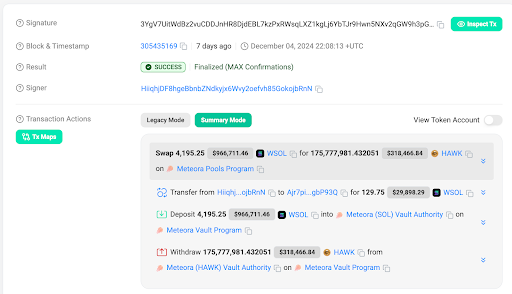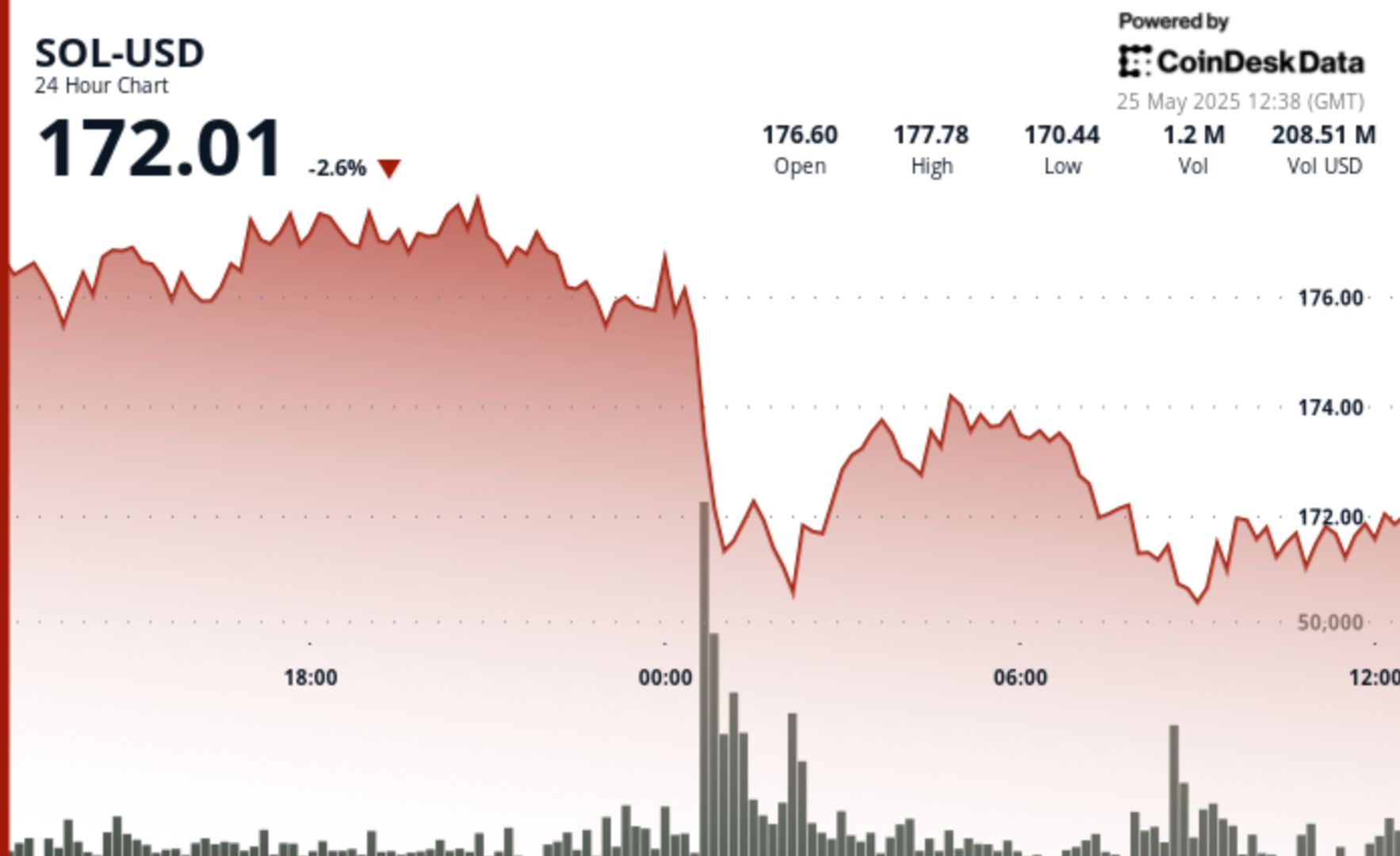Uncategorized
Haliey Welch’s $HAWK Shows Why We Need Better Standards for Memecoins

Haliey Welch, widely recognized as “Hawk Tuah,” transformed her fleeting viral fame into a formidable media empire. With a burgeoning social media presence (<a href=»https://www.instagram.com/hawktuah_/?hl=en» target=»_blank»>230K followers on Instagram</a>), lucrative brand partnerships, and the successful podcast Talk Tuah, Welch appeared to be transitioning from internet personality to business mogul.
That was until the 22-year-old launched her memecoin, $HAWK. Now Hawk Tuah isn’t flying so high.
$HAWK was launched on the Solana blockchain with considerable fanfare, initially skyrocketing to a <a href=»https://www.coindesk.com/markets/2024/12/04/hawk-tuah-sensation-haliey-welch-s-hawk-token-goes-live» target=»_blank»>$491 million market cap</a>. This meteoric rise was short-lived, as the coin’s valuation plummeted to <a href=»https://dexscreener.com/solana/exygvxvrvujjryo65vyuhlaccxhwyztkqa7jxqit2tvr» target=»_blank»>under $20 million</a>, according to data from DEX Screener.
The rapid decline raises questions about the project’s legitimacy and the motives behind its management. A now-deleted Twitter Spaces discussion further intensified suspicions, leading to <a href=»https://www.bbc.com/news/articles/c89xvjkzzyvo» target=»_blank»>widespread allegations that $HAWK is nothing more than a “celebrity rugpull.”</a>
To understand what happened, it is first necessary to examine the structure and decision-making processes that seemed to have underpinned the $HAWK launch.
Launching a memecoin might seem like a walk in the park (anyone can do it on Pump.fun). But doing it successfully is much harder. It requires capital, marketing and technical expertise alongside something good in the first place. You need teamwork. I say this as a founder who’s been in Web3 since 2013, has raised tens of millions of dollars in venture capital for projects of my own, and is a venture capitalist at a large venture fund, Foresight Ventures. (For more on how to launch a memecoin, see my other recent <a href=»https://www.coindesk.com/opinion/2024/12/12/memecoins-are-not-easy-money» target=»_blank»>CoinDesk article here</a>). $HAWK seems to have had three distinct teams behind it, according to internet sleuth <a href=»https://x.com/coffeebreak_YT?ref_src=twsrc%5Egoogle%7Ctwcamp%5Eserp%7Ctwgr%5Eauthor» target=»_blank»>Coffeezilla</a>:
Welch’s Web2 team, responsible for her “traditional” brand
<a href=»https://x.com/kbwofficial/status/1829866733743849600″ target=»_blank»>Memetic Labs, led by founder Doc Hollywood</a>, managing blockchain-related activities and holding the pen on all Web3 related decisions
and <a href=»https://x.com/overHere_gg» target=»_blank»>overHere</a>, a new technical service provider specifically brought in to facilitate a novel token claim process designed to onboard Welch’s Web2 audience.
OverHere initially engaged in discussions with me to provide context about its role and said it was open to providing anything more in a transparent manner.
In a since deleted X Spaces, Welch abruptly dropped off around 1:00am EST, telling listeners she was going to sleep. Doc Hollywood dominated the conversation. His company Memetics Labs was responsible for critical aspects of the token release, such as tokenomics, token minting and distribution, marketing (e.g. messaging over primary mediums such as X), liquidity pool creation, and trading fee settings.

One listener asked why the trading fees on Meteora were so high (Meteora is a decentralized exchange, or DEX, where users can trade cryptocurrencies directly, without middlemen.) Doc Hollywood said many of the expenses were related to costs associated with overHere’s team, as well as costs associated with setting up the foundation in the Cayman Islands. A claim partly refuted by overHere, who maintains it built the tech pro bono.
According to various industry sources who were made aware of the product’s only recent development, the social token utility technology overHere built had a new conceptual-business model. It’s one that would tokenize likeness and intellectual property tied to Web2 fans. And it’s not something that has existed in prior memecoin launches, let alone any crypto project.
Welch’s team, likely on the advice of Web3 adviser Memetic Labs, implemented exorbitant pool fees of 15% on Meteora, a decision that drew criticism from overHere when I first contacted on December 4. It seemed to maximize short term profits at the expense of the trust of both Welch’s existing Web2 community, as well as the Web3 community she hoped to expand into with this launch. High trading fees undermine the project’s credibility.
Another point of contention: the sale of millions of tokens post-launch by pre-sale investors, who were granted unrestricted access to vest their tokens. This effectively diluted the token’s value and raised suspicions of insider manipulation.
OverHere maintained its involvement was devoid of financial incentives, claiming no profits from Meteora or the pre-sale, and no access to free tokens. It described its focus as establishing $HAWK as a pioneering case study for leveraging intellectual property in token launches. However, the project’s trajectory, shaped by decisions from Welch’s Web3 team, was marred by mismanagement and missteps that made that impossible.
A lack of transparency emerges as the most significant failing in the $HAWK saga. The absence of a publicly disclosed tokenomics and distribution plan prior to the launch gave rise to accusations that the team was insider-dealing. Critics used <a href=»https://x.com/bubblemaps/status/1864439521523196046″ target=»_blank»>BubbleMaps, an auditing tool for DeFI and NFTs, to claim that 96% of the tokens were allegedly allocated to the “team.”</a> overHere later said <a href=»https://x.com/overHere_gg/status/1864503127019540912″ target=»_blank»>the actual distribution</a> for “the team” was 10%, which includes allocations for the community fund, reserves, and strategic purposes.
<a href=»https://x.com/overHere_gg/status/1864503127019540912″ target=»_blank»>According to overHere’s understanding</a>, the Web3 team — which maintained sole deployer wallet access — has denied selling these tokens. In reality, it appears this selling pressure originated from certain pre-sale investors whose involvement was never publicly disclosed prior to the launch. The initial confusion underscores a failure in communication and transparency from the outset.

Another issue was lock and vesting mechanisms were not immediately implemented, but this delay stemmed from technical bugs within the vesting protocol. All discussions regarding the token’s lock and vesting schedules were managed by Welch’s Web3 team in collaboration with Magna, the service provider overseeing these mechanisms. OverHere was intentionally uninvolved in these decisions, emphasizing its role as a technical service provider rather than an operational team. It has expressed a willingness to provide extensive documentation to clarify its position and responsibilities.
<a href=»https://x.com/jarxiao/status/1865111353318609150″ target=»_blank»>Industry experts such as Ellipsis’ Jarry Xiao</a> have said they didn’t think Welch’s team(s) had “malicious intent (this was clearly not their desired outcome). But without evidence to the contrary, this appears to be a blatant cash grab without any consideration of the consequences to retail.”
The story is a stark reminder of the perils inherent in merging celebrity influence with the nascent and often unregulated cryptocurrency market. The promise of decentralized finance funding media empires without traditional equity sales is alluring, yet $HAWK exposes the fragile foundation upon which such ventures are built. The lack of transparency, accountability, and ethical oversight can swiftly transform a promising project into a cautionary tale.
$HAWK is a testament to the critical need for robust governance frameworks and unwavering transparency in Web3 initiatives. As the team endeavors to rebuild trust and redefine $HAWK’s purpose, we, the crypto industry, must heed this lesson: without clear accountability and open communication, even the most promising projects are susceptible to collapse. We need to embed transparency and accountability at the core of all Web3 projects, particularly those of high-profile personalities who can just as easily become victims of exploitation.
Uncategorized
Chart of the Week: Bitcoin Soars, But ‘Wen Lambo’ Crowd Is Missing From the Rally

What happens when retail logs off from crypto and Wall Street tunes in? Looking at bitcoin’s BTC recent all-time-high, one would say it feels bullish and the industry is maturing.
That might as well be the case, but we might not be there yet. So before we floor our Lambos, let’s look under the hood.
First things first, retail investors have basically ghosted this rally. A quick search on Google Trends using the keyword «bitcoin» shows that the surge that was seen back in 2021’s bull market is non-existent. Back then, everyone and their grandmothers were Googling bitcoin, aping into altcoins and flooding the social media with rocket emojis. In 2025? It’s a ghost town in retail-land.
There was a blip of high retail interest surrounding the U.S. presidential election, when a short-lived memecoin mania took over retail sentiment. However, that surge is long gone, as memecoin prices tanked swiftly, even as bitcoin hit an all-time high this week, ripping past $111,000.

«Early in this cycle, memecoins became a concentration of risky retail-driven trading with related trading peaking in January,» said Toronto-based crypto platform FRNT Financial. «However, since then, there has been a virtual wash-out of interest and memecoin trading activity,» which shows «the tepid risk appetite in crypto at the moment,» FRNT added.
Translation: «Wen Lambo» crowd got burned, and they aren’t rushing back into the race track en masse anytime soon.
From Lambos to Corollas
On the topic of risk appetite, let’s go back to the car analogy.
During the 2021 bull market, people bought unreliable performance cars, stripped out the brakes and seatbelts to go faster than ever before, and did not care that there might be engine blowouts. As long as there was a promise of reaching the moon, bullish vibes were all that mattered.
Now? After losing tremendous amounts of money on those unsustainable go-fast cars for years, traders are driving Toyota Corollas—sensible sedans that are slow but steady and still on the road.
That risk-off sentiment is also evident from the funding rates, according to FRNT’s analysis of BTC perp rates—a measure of how much traders are willing to pay to maintain their long positions. When bitcoin reached a record high of around $42,000 in January 2021, the perp rate was about blistering 185%. Today, at bitcoin near $110,000, the rate is near 20% on crypto options exchange Deribit, meaning the risk appetite isn’t completely gone but nowhere near the 2021 frenzy.

ATH jitters
A third point to add is the high number of short positions in the market.
As CoinDesk’s Oliver Knight reported this week, the bitcoin long/short ratio is at its lowest point since the crypto winter in September 2022. This implies that the majority of the traders aren’t completely buying into this recent positive momentum and betting on bitcoin moving lower as a hedge for the new bullish rally.

The impact of such positioning was clear on Friday, when bitcoin swiftly crashed from near $111,000 to $108,000 in a matter of minutes and then bounced right back up to $109,000. The anxiety of a swift volatility is real.
So in a car-themed analogy, the drivers (in this case, investors) are still taking out their super-modified, unreliable sports cars for a weekend drive on the track. Still, they also have their Corollas following along. Just in case the engine blows on their go-fast cars.
Cautious optimism
Given the current macro-risk, it’s not entirely surprising that investors are on their toes and risk-averse. But this might just be exactly what your mechanic at the shop prescribed. In fact, this might be an indicator of a sustainable rally in the long term.
«Periods of low leverage and risk appetite in crypto have often preceded further sustainable gains,» according to FRNT.
«BTC appears to be in such a phase, set against a backdrop of numerous bullish catalysts and narratives,» the firm added.
The bottom line is that the retail Lambos might have been towed away, but big money is stepping in with their everlasting Toyotas. This might start a slow but steady race to the moon, not just a reckless joyride.
Uncategorized
Solana Plunges 5% as Midnight Sell-Off Signals Institutional Exit

The cryptocurrency market faces renewed pressure as Solana (SOL) dropped below its stable $177 trading range, reflecting broader concerns about global economic stability.
The correction coincides with increasing geopolitical tensions that have rattled financial markets worldwide, forcing investors to reassess risk exposure across digital assets.
Despite the pullback, Solana’s ecosystem continues to expand with R3’s strategic pivot to integrate with its blockchain, signaling growing institutional interest in the platform’s capabilities for tokenizing real-world assets.
Technical Analysis Highlights
- SOL price dropped from stable $177 range to find support at $170.41, representing a 4.5% correction.
- Dramatic volume spike to 1.26M occurred during midnight hour when prices fell below $172.
- Support levels established at $170.67-$171.66 have held thus far.
- Price attempted recovery toward $174 level before facing resistance.
- In the last hour, SOL declined from $172.93 to $172.00.
- Significant price drop occurred at 08:00, briefly touching $171.92 before recovering.
- Volume spiked to 29,372 units during this minute, suggesting institutional selling pressure.
- Temporary support found at $171.80-$171.85 range around 07:30-07:31.
- Local high of $172.35 reached at 07:36 during recovery attempt.
- Price continues to consolidate near $172 support level.
External References
- «Solana (SOL) Price Flexes Bullish Momentum, Analysts Eye Major Breakout Beyond $250«, Coin Edition, published May 23, 2025.
- «Can Solana Break the $180 Resistance? Here’s What SOL Price Will Be Worth in 2025!«, CoinPedia, published May 24, 2025.
- «Solana MACD Curling Up – Is This The Prelude To A Breakout?«, NewsBTC, published May 24, 2025.
Uncategorized
Judge Overturns Convictions in Mango Markets Exploiter’s Crypto Fraud Case

A U.S. judge has overturned the fraud and market manipulation convictions of Avraham Eisenberg, the crypto trader accused of draining $110 million from the now-defunct decentralized finance protocol Mango Markets.
On Friday, U.S. District Judge Arun Subramanian ruled that prosecutors failed to prove Eisenberg made false representations to the platform.
He also moved to acquit Eisenberg of wire fraud charges. The investor manipulated the price of Mango’s native token MNGO with massive trades by more than 1,000% in 20 minutes before getting the protocol to allow him to borrow and withdraw $110 million in various cryptocurrencies, backed by the inflated collateral.
Eisenberg’s defense argued that the platform, which operated through smart contracts, allowed anyone to transact freely and that he simply exploited a vulnerability. The judge agreed, stating that Mango’s permissionless structure meant that there “was insufficient evidence of falsity” from prosecutors regarding Eisenberg’s representation to Mango Markets.
Eisenberg was arrested in December 2022, and while this case collapsed, he is still currently serving a four-year sentence handed out after he pleaded guilty to the possession of child sexual abuse material.
“From the beginning, we said this case was fatally flawed,” his attorney Brian Klein of Waymaker LLP said. “We are very pleased for Avi that the judge granted our motion and dismissed the case.”
-

 Fashion7 месяцев ago
Fashion7 месяцев agoThese \’90s fashion trends are making a comeback in 2017
-

 Entertainment7 месяцев ago
Entertainment7 месяцев agoThe final 6 \’Game of Thrones\’ episodes might feel like a full season
-

 Fashion7 месяцев ago
Fashion7 месяцев agoAccording to Dior Couture, this taboo fashion accessory is back
-

 Entertainment7 месяцев ago
Entertainment7 месяцев agoThe old and New Edition cast comes together to perform
-

 Business7 месяцев ago
Business7 месяцев agoUber and Lyft are finally available in all of New York State
-

 Sports7 месяцев ago
Sports7 месяцев agoPhillies\’ Aaron Altherr makes mind-boggling barehanded play
-

 Sports7 месяцев ago
Sports7 месяцев agoSteph Curry finally got the contract he deserves from the Warriors
-

 Entertainment7 месяцев ago
Entertainment7 месяцев ago\’Better Call Saul\’ has been renewed for a fourth season





